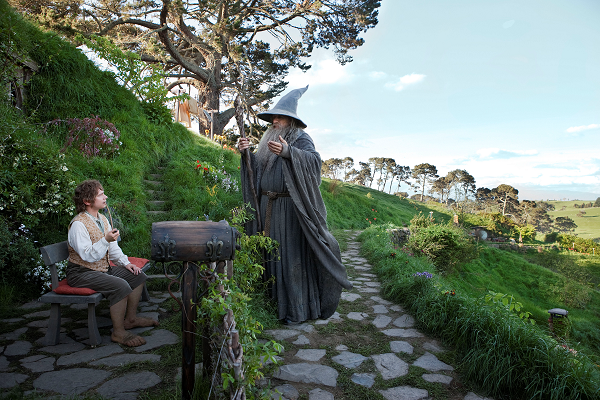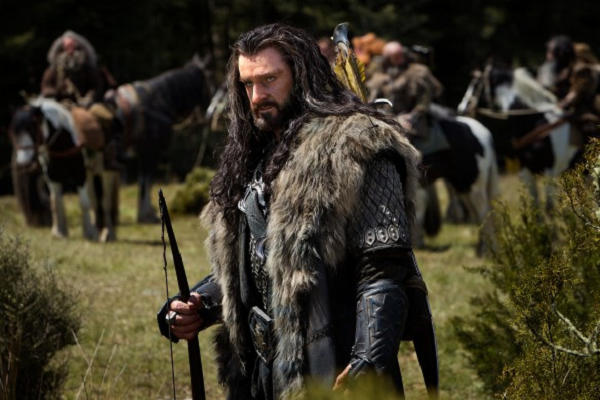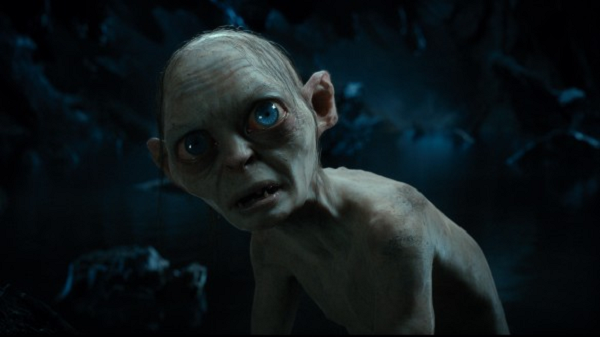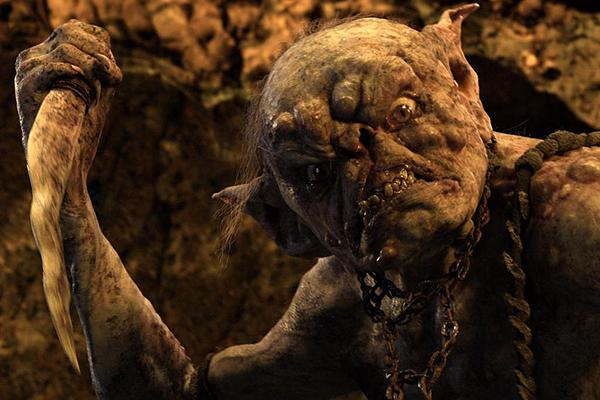The Hobbit: An Unexpected Journey Review (Second Take)
The original
Lord of the Rings is one of the best novel series and film series ever and it has been a long journey for the adaptation of
The Hobbit.
The Hobbit: An Unexpected Journey is a welcome returned to Middle-Earth, even if it does not match the heights of the original trilogy.
The Kingdom of Erebor is the greatest Dwarf kingdom in Middle-Earth. It was built on the wealth of the materials of The Lonely Mountain. But the Dwarfs of the kingdom are exiled after Smaug the Dragon overruns the Dwarf forces and the Elves refuse to help. The rightful king of the kingdom, Thorin Oakenshield (Richard Armitage) is determined to reclaim his birth right no matter the cost, and with 12 other dwarfs at his side, goes on a quest to recapture The Lonely Mountain.

Gandalf the Grey (Ian McKellen) is a part of the dwarf company, wanting to ensure Smaug does not ally with other dark forces of Middle-Earth, and it is up to him to find the 14th member of the company. He decides to recruit the hobbit Bilbo Baggins (Martin Freeman) as a burglar because hobbits are light on their feet, even though Bilbo has never set foot out of The Shire and is too attached to his home comforts.
Besides a fiery death, many outside factors affect the company’s quest: a lack of support from other dwarfs, the political tensions between Thorin and the elves and the return of an old threat to Middle-Earth. The company is also being hunted by Thorin’s great rival, Azog (Manu Bennett) “The Pale Orc,” who looks very much like an Orc version of Kratos from the
God of War series.
 The Hobbit
The Hobbit is a much shorter novel then any of
The Lord of the Rings novels; it clocks in at around 400 pages. To make it into a new trilogy, Peter Jackson and his team had to expand the story using expanded material from Tolkien stories and a little bit of artistic license. Elements of the story from the novel have been altered and embellished, such as the rivalry between Thorin and Azog, the Elves saving the Dwarfs before reaching Rivendell and the events involving Radagast the Brown (Sylvester McCoy) discovering a new evil in Mirkwood. Of course the previous trilogy also embellished the story, particularly
The Two Towers. For fans of the original novel there are some fun references, from lines of dialogue and voiceover to the story of Bilbo’s ancestor.
Jackson employs a lighter tone for the prequel, using more comedy than previous films. Of course there was comedy in the original trilogy and the tone of
The Hobbit was written as children’s novel. When the dwarfs arrive at Bilbo’s home it was tonally light and there are some genuinely funny moments, particularly involving the trolls and the dwarfs. Because of the nature of the story and the way it was told it is a slightly more family friendly film.
 The Hobbit: An Unexpected Journey
The Hobbit: An Unexpected Journey stills supplies plenty of fantasy action that you want and expect. Jackson delivers plenty top-notch special effects and creative action sequences when they are on screen, especially the fight within the Misty Mountains. As a fan, there were some nice little improvements, the biggest being the wargs which actually looked like wolves, not those silly looking hydras that they were in
The Two Towers. Fans can also look forward to another fantastic score provided by Howard Shore, hitting every note perfectly.
Jackson does assemble a great cast for the prequel. Of course old players like McKellen, Andy Serkis and co. do their parts justice and Armitage was perfect as Thorin. Armitage brought to life the bitter warrior longing for crown, a seriously minded fellow who did provide on the action stakes. Freeman was also a strong performer as the hobbit in question, the reluctant hero of the piece who is forced to come into his own.

A problem with the movie is some inconsistencies with the Dwarfs in terms of some being more prominent than others. Balin and Bofur were played by recognizable actors Ken Stott and James Nesbitt and their profile led to them having decent screentime. But other characters simply disappear off the screen, having no personality or characteristics and are just noticeable because of their appearance. This despite the profiles the studio created. But this is also a problem with the novel where some of the dwarfs felt like they did not need to be in the movie.
The running time is 2 hours 50 minutes, which is long. A straight adaptation of
The Hobbit would have easily have fit into a film lasting even less than that. Some scenes could have been trimmed and the scenes involving the wider context felt inconsequential at the moment. But
The Hobbit: An Unexpected Journey does not disgrace the legacy of the original trilogy and it is still one of the best medieval set fantasy films since
Return of the King.
 Gandalf the Grey (Ian McKellen) is a part of the dwarf company, wanting to ensure Smaug does not ally with other dark forces of Middle-Earth, and it is up to him to find the 14th member of the company. He decides to recruit the hobbit Bilbo Baggins (Martin Freeman) as a burglar because hobbits are light on their feet, even though Bilbo has never set foot out of The Shire and is too attached to his home comforts.
Besides a fiery death, many outside factors affect the company’s quest: a lack of support from other dwarfs, the political tensions between Thorin and the elves and the return of an old threat to Middle-Earth. The company is also being hunted by Thorin’s great rival, Azog (Manu Bennett) “The Pale Orc,” who looks very much like an Orc version of Kratos from the God of War series.
Gandalf the Grey (Ian McKellen) is a part of the dwarf company, wanting to ensure Smaug does not ally with other dark forces of Middle-Earth, and it is up to him to find the 14th member of the company. He decides to recruit the hobbit Bilbo Baggins (Martin Freeman) as a burglar because hobbits are light on their feet, even though Bilbo has never set foot out of The Shire and is too attached to his home comforts.
Besides a fiery death, many outside factors affect the company’s quest: a lack of support from other dwarfs, the political tensions between Thorin and the elves and the return of an old threat to Middle-Earth. The company is also being hunted by Thorin’s great rival, Azog (Manu Bennett) “The Pale Orc,” who looks very much like an Orc version of Kratos from the God of War series.
 The Hobbit is a much shorter novel then any of The Lord of the Rings novels; it clocks in at around 400 pages. To make it into a new trilogy, Peter Jackson and his team had to expand the story using expanded material from Tolkien stories and a little bit of artistic license. Elements of the story from the novel have been altered and embellished, such as the rivalry between Thorin and Azog, the Elves saving the Dwarfs before reaching Rivendell and the events involving Radagast the Brown (Sylvester McCoy) discovering a new evil in Mirkwood. Of course the previous trilogy also embellished the story, particularly The Two Towers. For fans of the original novel there are some fun references, from lines of dialogue and voiceover to the story of Bilbo’s ancestor.
Jackson employs a lighter tone for the prequel, using more comedy than previous films. Of course there was comedy in the original trilogy and the tone of The Hobbit was written as children’s novel. When the dwarfs arrive at Bilbo’s home it was tonally light and there are some genuinely funny moments, particularly involving the trolls and the dwarfs. Because of the nature of the story and the way it was told it is a slightly more family friendly film.
The Hobbit is a much shorter novel then any of The Lord of the Rings novels; it clocks in at around 400 pages. To make it into a new trilogy, Peter Jackson and his team had to expand the story using expanded material from Tolkien stories and a little bit of artistic license. Elements of the story from the novel have been altered and embellished, such as the rivalry between Thorin and Azog, the Elves saving the Dwarfs before reaching Rivendell and the events involving Radagast the Brown (Sylvester McCoy) discovering a new evil in Mirkwood. Of course the previous trilogy also embellished the story, particularly The Two Towers. For fans of the original novel there are some fun references, from lines of dialogue and voiceover to the story of Bilbo’s ancestor.
Jackson employs a lighter tone for the prequel, using more comedy than previous films. Of course there was comedy in the original trilogy and the tone of The Hobbit was written as children’s novel. When the dwarfs arrive at Bilbo’s home it was tonally light and there are some genuinely funny moments, particularly involving the trolls and the dwarfs. Because of the nature of the story and the way it was told it is a slightly more family friendly film.
 The Hobbit: An Unexpected Journey stills supplies plenty of fantasy action that you want and expect. Jackson delivers plenty top-notch special effects and creative action sequences when they are on screen, especially the fight within the Misty Mountains. As a fan, there were some nice little improvements, the biggest being the wargs which actually looked like wolves, not those silly looking hydras that they were in The Two Towers. Fans can also look forward to another fantastic score provided by Howard Shore, hitting every note perfectly.
Jackson does assemble a great cast for the prequel. Of course old players like McKellen, Andy Serkis and co. do their parts justice and Armitage was perfect as Thorin. Armitage brought to life the bitter warrior longing for crown, a seriously minded fellow who did provide on the action stakes. Freeman was also a strong performer as the hobbit in question, the reluctant hero of the piece who is forced to come into his own.
The Hobbit: An Unexpected Journey stills supplies plenty of fantasy action that you want and expect. Jackson delivers plenty top-notch special effects and creative action sequences when they are on screen, especially the fight within the Misty Mountains. As a fan, there were some nice little improvements, the biggest being the wargs which actually looked like wolves, not those silly looking hydras that they were in The Two Towers. Fans can also look forward to another fantastic score provided by Howard Shore, hitting every note perfectly.
Jackson does assemble a great cast for the prequel. Of course old players like McKellen, Andy Serkis and co. do their parts justice and Armitage was perfect as Thorin. Armitage brought to life the bitter warrior longing for crown, a seriously minded fellow who did provide on the action stakes. Freeman was also a strong performer as the hobbit in question, the reluctant hero of the piece who is forced to come into his own.
 A problem with the movie is some inconsistencies with the Dwarfs in terms of some being more prominent than others. Balin and Bofur were played by recognizable actors Ken Stott and James Nesbitt and their profile led to them having decent screentime. But other characters simply disappear off the screen, having no personality or characteristics and are just noticeable because of their appearance. This despite the profiles the studio created. But this is also a problem with the novel where some of the dwarfs felt like they did not need to be in the movie.
The running time is 2 hours 50 minutes, which is long. A straight adaptation of The Hobbit would have easily have fit into a film lasting even less than that. Some scenes could have been trimmed and the scenes involving the wider context felt inconsequential at the moment. But The Hobbit: An Unexpected Journey does not disgrace the legacy of the original trilogy and it is still one of the best medieval set fantasy films since Return of the King.
A problem with the movie is some inconsistencies with the Dwarfs in terms of some being more prominent than others. Balin and Bofur were played by recognizable actors Ken Stott and James Nesbitt and their profile led to them having decent screentime. But other characters simply disappear off the screen, having no personality or characteristics and are just noticeable because of their appearance. This despite the profiles the studio created. But this is also a problem with the novel where some of the dwarfs felt like they did not need to be in the movie.
The running time is 2 hours 50 minutes, which is long. A straight adaptation of The Hobbit would have easily have fit into a film lasting even less than that. Some scenes could have been trimmed and the scenes involving the wider context felt inconsequential at the moment. But The Hobbit: An Unexpected Journey does not disgrace the legacy of the original trilogy and it is still one of the best medieval set fantasy films since Return of the King.